Textile production and
clothing
Other uses in ancient Egypt
Woven textiles, and objects made of twisted thread in "non-woven"
techniques, had many other applications in Egypt besides clothing, such as sacks
and sails. Some examples of other uses, from the Petrie Museum, are given here.
Saqqara,
fragment of looped bed cover, front and back, UC 38955, dated by the excavator
Vassalli to the "prime dinastie" ('early dynasties', perhaps at the time of
that excavation referring to the Old Kingdom, about 2500 BC)
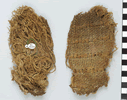 |
Textiles were also used for bedding. The large rectangular
piece of clothing, ifd, was probably used as a cover at night as well
as by day. In addition, in wealthier households at least, a type of
textile would also have been found that was specific to beds, a thick
cloth with long loops on one face. The term in Egyptian seems to have
been xrr (Manuel de Codage rendering of the Egyptian consonants for
the Internet, vocalised perhaps kherer). The xrr would have been used
between the sleeper and the webbing of the bed itself. The loops would
have provided both padding and insulation and this type of textile can
therefore be compared in its effect to the animal furs found in many
early burials. The xrr from Merit's bed in the 18th Dynasty tomb
of Kha and Merit had been placed with the looped face downwards. |
Lahun,
a sealed bag and a small bundle (UC 7502 and 7423), probably late Middle
Kingdom (about 1850-1750 BC)
 |
Textiles were also used to contain and protect other
materials. On the left, a small bag of woven linen containing an organic
substance now hard and black, perhaps some sort of medicine. The contents
have been secured by a thread wrapped round the bag's neck which on
one side is covered with a mud seal. The seal has been impressed twice
with a seal-amulet. On the right, a small bundle containing some sort
of mineral has been made from a corner torn from a large linen rectangle
or ifd. The bundle has been tied up with one of the plaited elements
of the warp fringe (part of the selvedge fringe is also present).
|
Tarkhan, pottery jar with
a painted "carrying net", UC 17286, First Dynasty (about 3000 BC)
 |
Ceramic storage jars would often have been provided with
linen nets. These nets were used to carry the jars and to hang them
up. The longevity of this tradition is illustrated in the Petrie collection
by the predynastic jar with painted lines representing a carrying net
and by a large Byzantine period jar, UC
75883, with the remains of actual net of knotted palm fibre cord.
Surviving carrying nets of the Dynastic period are usually made of linen
in a knotless technique now known as now known as "looping". |
Fragmentary fishing
nets from Lahun (left UC 7512 iv,
late Middle Kingdom, about 1850-1750 BC) and Gurob
(right UC 27885 ii, New Kingdom, about 1550-1069 BC)
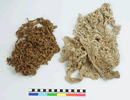 |
The Petrie Museum has a particularly fine collection of knotted
nets from two sites in the Fayum, Lahun and Gurob. Nets were used for hunting
animals and catching birds, but the situation of these two sites, on the
edge of the Fayum, suggest these examples were fishing nets. They are of
various shapes and grades, but all are made of linen thread, using the method
of knotting still universal for fishing nets. |
Lahun, fishing hook and line, and two types of
rope (UC 7250, 7505 iv & 7508 iii) late Middle Kingdom, about 1850-1750
BC
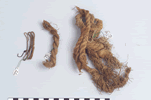 |
A length of fishing "line", complete with bronze hook, again
reflects the importance of linen to the fishing industry. |
The bundle of rope shows how linen was also used to make more substantial
cordage. Because the ancient Egyptians never processed flax/linen as a loose
mass of fibre, linen rope had to made up from many individually-twisted threads.
In the part of this rope examined, the two main elements making up the rope
were found each to consist of c.135 individual threads, that is, when twisted
together, a total of c.270. The shorter length of rope in the centre of the
picture is made from a relatively coarse plant fibre, perhaps halfa grass. It
would have been quicker to make but much less strong.
Lahun, sling (UC 6921 ), late Third Intermediate
Period (about 800 BC)
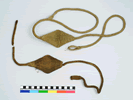 |
Sling of braided linen shown with modern reproduction. Slings
were used to kill small animals and birds. This example was found with
iron arrowhead, indicating a date later than the Bronze Age.
|
Deir el-Bahari, votive textile, woven linen with
beads (UC 51387), Eighteenth Dynasty (about 1450 BC)
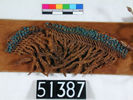 |
A variety of small cloths found in the Temple of Hathor at
Deir el-Bahari seem to have had a specific votive purpose, that is, to have
been given to the goddess in support of a prayer or invocation. Some of
these cloths incorporate non-textile material, including mud and straw.
This fragmentary example has beads threaded onto the warp in a way that
is never found in textiles used in daily life. The plaited fringe is also
unusually elaborate. |
Tarkhan, knotted linen cords as amulets (UC
52197A and B), late Third Intermediate Period (about 700 BC)
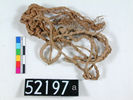 |
Amulets found in eighth century BC burials at sites such as
Tarkhan/Kafr Ammar include knotted linen
cords. The knots presumably had a religious significance. The longevity
and extent of use of this custom remain to be researched. |
Unprovenanced, lower leg from mummy,
UC 34362, Ptolemaic Period
 |
The fate of very many worn out textiles was to be used in
burials. Egyptian mummies, originally wrapped in complete cloths as if dressed,
over the centuries became increasingly elaborate, provided with textile
padding below and torn strips or "bandages" above. In the Ptolemaic period,
the limbs of mummies were often separately wrapped. This leg fragment illustrates
well the fine art of mummy wrapping at this time, an apotheosis of rags. |
Copyright © 2003 University College London. All rights
reserved.







